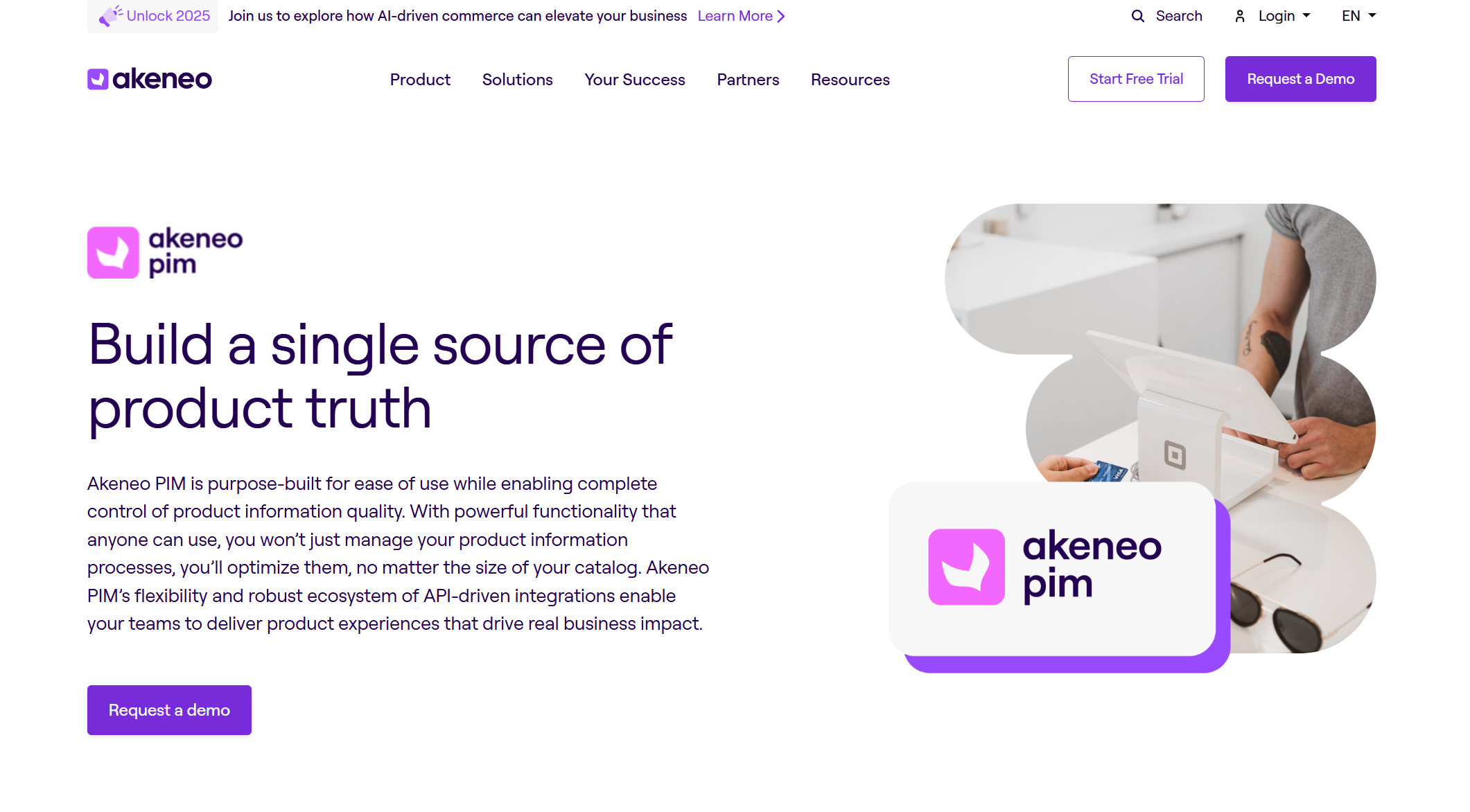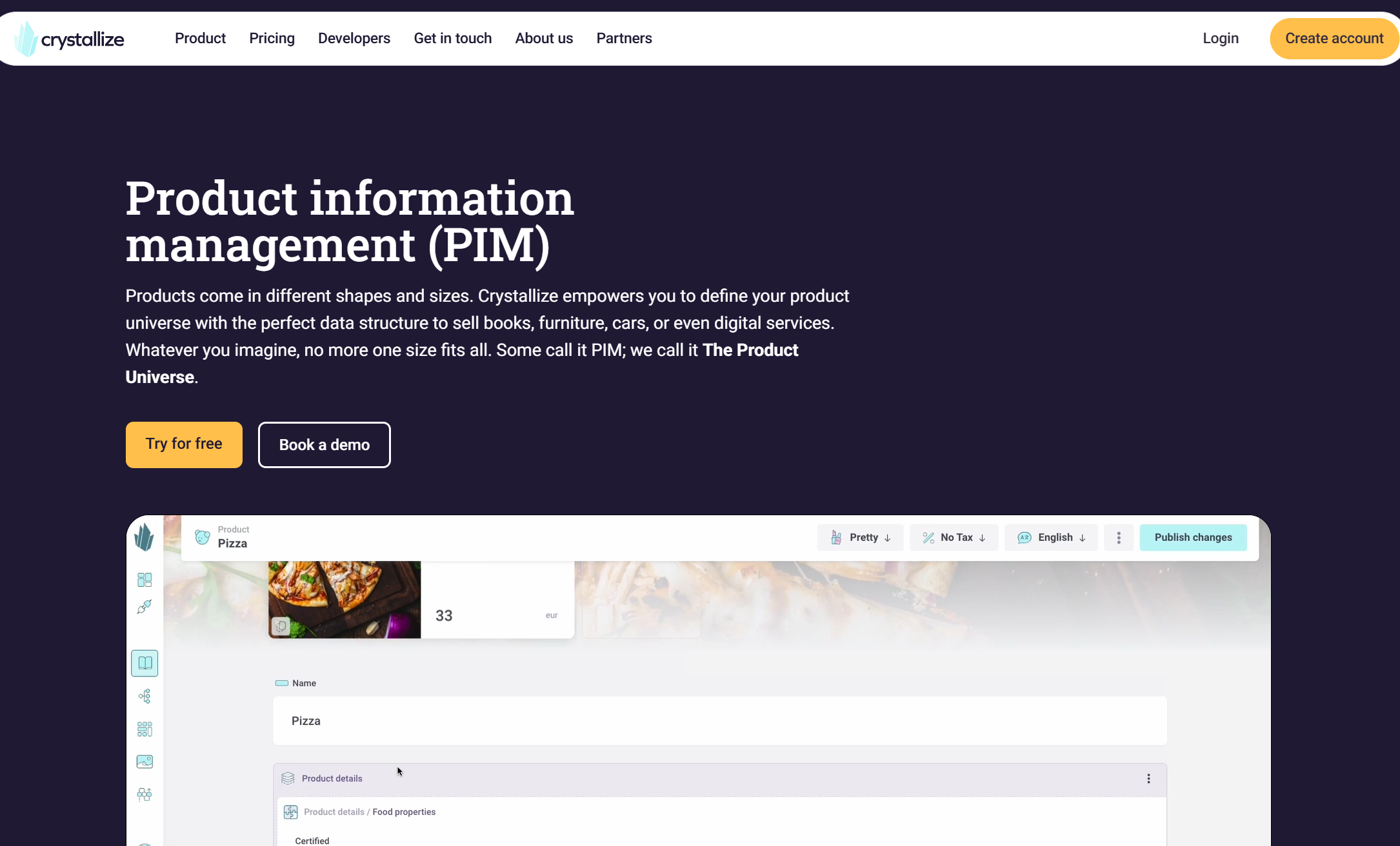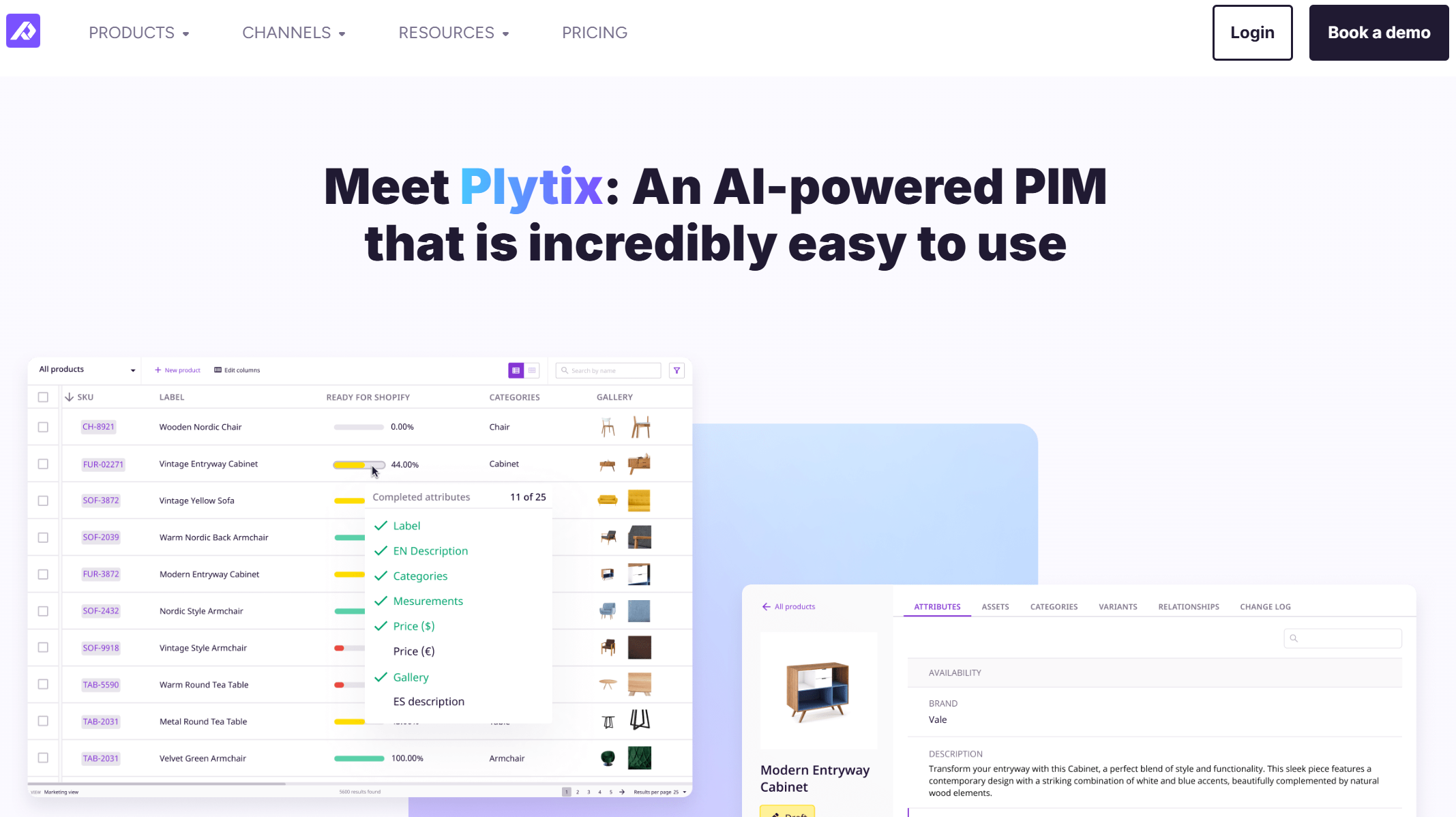Best PIM Platforms in 2025: Compare the Top 8 Solutions Side-by-Side
Psst: we are hiring remote frontend developers and backend developers.

Nowadays, everyone (Millennials, Gen Zs, and even us older folks) knows what they want, whether they're shopping online or in a store. They expect a personalized experience and quick service. A whopping 90% of consumers expect the same product information across all channels – whether browsing online, in an app, or in a physical store (source: ).
To hit those expectations, you've gotta keep your product info database accurate, consistent, and up to date. That's a tough gig, especially for big companies selling tons of products across different channels.
That's where platforms come in. They're leading the charge, giving companies unparalleled organization, efficiency, and scalability.
But not all PIMs are created equal.
TL;DR: At-a-Glance Comparison of the Best PIM Platforms (2025)
Before we dive into each PIM in detail, here’s a side-by-side comparison of core features you’ll want to consider:
Why PIM Matters (More Than You Think)
70% of shoppers will bounce if product data is missing or inconsistent. That’s not just a UX problem—it’s revenue walking out the door. A modern Product Information Management (PIM) platform changes the game by centralizing, cleaning, and syncing your product content across every channel that matters.
Here’s what that means for your business:
- No more internal chaos. Say goodbye to scattered spreadsheets and version-control nightmares. PIM gives sales, marketing, and ops one shared source of truth—so everyone’s aligned, fast.
- Consistent experiences everywhere. Whether a customer’s on your DTC site, scrolling a marketplace, or browsing in-store, PIM ensures product data is accurate, rich, and up-to-date—everywhere, every time.
- Faster time-to-market. Launching new SKUs doesn’t have to take months. PIM adopters move 2× faster and report a 20–50% boost in online conversions thanks to cleaner, more persuasive product content (PIM Stats 2025).
Put simply: if product data is your brand’s lifeblood, PIM is your circulatory system.
Choosing the Perfect PIM: A Strategic Decision for Modern Enterprises
Picking a PIM isn't just about grabbing a tool; it's about finding one that really fits where your business is headed and what you want to achieve.
For example, today's businesses use a wide range of tools, including Customer Relationship Management (CRM), Enterprise Resource Planning (ERP), and e-commerce platforms. The PIM you choose shouldn't just sit there by itself; it should seamlessly integrate with these other tools. That way, data flows smoothly, and you avoid those annoying data mix-ups and duplicates.
Your PIM should really be your partner as your business grows. The perfect PIM solution should scale with you. Whether you're adding more products or jumping into new markets, the platform should easily handle bigger data loads without slowing down.
And finally, a tool is only good if people actually use it. Even the PIMs packed with the most features can fall flat if they're a pain to use. A user-friendly interface means your team can pick it up quickly, leading to faster adoption and better overall efficiency.
Overview of the Best PIM Platforms on the Market in 2025
Before we dig into available options, let me be fully transparent here. YES, most of these are Crystallize competitors, but we truly admire the products and teams behind them. Just as Crystallize is not for everyone, neither are these; i.e., while some overlap is bound to occur, each has use cases where it shines.
Besides, as I/we already mentioned in our , we prefer to discuss the most popular solutions rather than rank them as the best. It’s up to you and your team to determine which best fits your business needs.
Let’s kick it👇
[h3]Akeneo PIM
Akeneo's PIM solution is a flexible, scalable platform available in open-source and cloud-based versions, enabling businesses to centralize and harmonize product information across multiple channels. Its powerful features are particularly beneficial for managing extensive product catalogs, but potential adopters should consider the learning curve, setup complexity, and implementation costs.

Akeneo ensures that consistent product information is delivered across all channels. This uniformity enhances customer experience and trust in the brand. With centralized product data, businesses can avoid redundancy, resulting in a quicker time-to-market.
Being open-source, Akeneo offers scalability and customization, enabling businesses to tailor the system to their specific requirements and grow seamlessly. It also provides connectors for popular e-commerce platforms such as Magento, Shopify, and WooCommerce, enabling seamless integration and data synchronization.
Akeneo promotes collaboration by allowing multiple team members to work on product listings simultaneously, enhancing productivity and ensuring data accuracy.
Disadvantages? First, newcomers can have a steep learning curve, as with many robust platforms. While open-source allows for extensive customization, setting up the platform and tailoring it to specific needs can be complex. Also, integrating Akeneo into existing systems can be complex and may require the involvement of developers and IT specialists.
Although Akeneo's Community Edition is free, the Enterprise Edition, which has more features and support, can be expensive for smaller businesses.
Some users have reported performance issues, especially when using many products. It is crucial to ensure that your server setup can handle the volume of product data.
Finally, out-of-the-box DAM capabilities are not great—many report they are better off integrating separate DAM solutions.
Best for: Mid-sized to enterprise-level brands managing large product catalogs, especially in B2C retail. Ideal for businesses that need localization and multichannel syndication and have technical teams to handle setup and customization.
Pricing and implementation (assessed according to available data at the time of publishing the article). Offers a free open-source Community Edition, with enterprise SaaS plans starting around $25,000 per year. Implementations typically take a few months (~6 months), and users report solid satisfaction (approximately 4.4 out of 5 stars on G2).
How does Akeneo compare to other PIM platforms? Visit our comparison pages, starting with 😆
[h3]Crystallize
As the only true headless PIM solution, WE (Crystallize) tends to position ourselves distinctively in the e-commerce platform space by marrying PIM functionality with headless commerce. This approach caters to brands seeking performance, scalability, and rich storytelling. It is particularly apt for businesses keen on subscription models or those with unique product stories to tell.

An intuitive UI that unifies Commerce, PIM, and CMS delivers , ensuring high-speed, responsive, and custom-tailored user experiences. Unlike other solutions, Crystallize focuses on , enabling brands to create immersive product narratives that elevate customer experience. To go beyond product information.
Integrated Product Information Management ensures centralized, consistent product data, streamlining management and distribution, while integrated CMS capabilities enable you to market your products from a single source.
It is designed for growth. The platform provides the flexibility to handle expanding product lines and increasing traffic. Crystallize recognizes the growth of and offers specialized tools to manage and optimize subscription products.
Are there any cons? As with any headless solution, businesses unfamiliar with the model can experience a steeper learning curve, especially when integrating the back end and front end. Not a plug-and-play solution, but it requires configuration and development.
Given its technical architecture, it is fair to say that continuous tweaks or changes might require regular involvement from developers, unlike traditional platforms, where non-tech users can make adjustments.
Best for: Fast-growing commerce teams looking for a headless, API-first PIM + CMS combo. Suited to businesses prioritizing developer flexibility, composable commerce, and delivering product-rich experiences across multiple touchpoints.
Pricing and implementation. Provides a freemium model (free “Particle” tier) and paid plans (e.g. Atom tier ~$949/month). It’s built for fast deployment (often within weeks), and current user reviews give it roughly a 4.2/5 rating on G2.
👉 Interested in a modern PIM + commerce solution? Book a demo with Crystallize.
[h3]Salsify
Salsify stands at the forefront of Product Experience Management (PXM) evolution, offering a robust suite that meets the multifaceted demands of modern digital commerce. Its amalgamation of Product Information Management (PIM), Digital Asset Management (DAM), and syndication tools is particularly beneficial for businesses aiming to streamline operations across multiple retail platforms and enhance their digital presence.
As a PXM suite, Salsify is a comprehensive platform for brands to manage and optimize product experiences across diverse channels. Unlike classic PIM systems, it offers dynamic data modeling, enabling businesses to adapt quickly to changing market requirements without extensive reconfigurations.
With its syndication capabilities, you can customize product content as per the specifications and nuances of different retailers, ensuring consistency and compliance.
Finally, it provides insights into product performance across different channels, aiding data-driven decision-making.
Salsify cons. OFC's comprehensive toolset comes with an inherent learning curve. Teams may need training to effectively harness the platform's full potential. For businesses transitioning from simpler systems, for example, Salsify's powerful workflow can seem complex and require realignment of processes.
While Salsify offers various integration options, integrating with legacy systems or niche platforms might pose challenges. The cost of Salsify can be a consideration for smaller businesses. Some relative to the features offered.
Best for: Large enterprises with complex omnichannel operations and strong retail distribution networks. It excels in product experience management (PXM) and digital shelf analytics, but comes with a premium price tag.
Pricing and implementation. An enterprise-focused PIM/PXM with pricing around $2,000+ per month (typically quote-based for full deployments). Implementations commonly span a few months (~4 months), and they earn strong user reviews (about 4.4 out of 5 on G2).
How does Salsify compare to other PIM platforms? Visit our comparison pages, starting with Crystallize vs. Salsify😆
[h3]Pimcore
Pimcore, a comprehensive platform frequently marketed as DXP and MDM, combines Product Information Management (PIM), Digital Asset Management (DAM), Content Management System (CMS), and other digital commerce functionalities. Its modular architecture caters to various industries, including retail, manufacturing, wholesale, consumer packaged goods, media, travel, and healthcare.

However, it is important to consider the potential complexities and costs associated with implementing Pimcore.
Built on PHP and using frameworks such as Symfony and ExtJS, Pimcore provides developers with a familiar environment for customization and extension, facilitating tailored solutions. Additionally, Pimcore is open-source, offering high flexibility and adaptability. Organizations can tailor the platform to fit their unique needs without being constrained by proprietary limitations.
Additionally, Pimcore's API-driven approach makes integrating with other systems, such as ERP, CRM, or third-party applications, easy.
Despite its robust capabilities, Pimcore offers an intuitive interface, making it user-friendly for non-technical users to manage content and assets.
Extensive functionalities also mean a significant learning curve, especially for those unfamiliar with PIM, DAM, or CMS systems and their business roles. Training may be required to harness the system's full potential.
Downsides? While its open-source nature allows for customization, it also demands expertise to ensure it is tailored accurately to a business's needs. For example, deploying Pimcore may be complex, requiring experienced developers and thorough planning to integrate seamlessly with existing systems.
This leads to performance concerns, i.e., if the system is not optimally configured, especially when managing vast volumes of data or high-resolution digital assets.
As with many open-source platforms, community support is available, but premium support might be available at an additional cost. Moreover, ensuring regular updates and maintenance might require dedicated IT resources.
Finally, while the platform is open-source and free, costs can escalate when considering customization, integration, hosting, and support, which might concern smaller enterprises.
Best for: Enterprises seeking an open-source, all-in-one solution that combines PIM, MDM, DAM, and CMS capabilities. Best suited for teams with in-house developers who want complete control over customization and data modeling.
Pricing and implementation. Open-source platform (Community Edition is free) with paid enterprise subscriptions starting roughly at $1,550 per month. Implementation usually takes ~6 months, and it enjoys high user satisfaction (around 85%, ~4.4/5 on G2).
How does Pimcore compare to other PIM platforms? Visit our comparison pages, starting with 😆
[h3]Inriver
Inriver is a comprehensive PIM platform designed to help businesses centralize, manage, and distribute product information across various channels. It caters to brands, manufacturers, and retailers aiming to streamline their product information management. It's particularly beneficial for organizations operating in complex omnichannel environments that require efficient control over product experiences.
The platform's flexible data model and composable architecture enable it to adapt to evolving business needs and complex data structures. It also utilizes AI to automate and optimize product information processes, enhancing efficiency and responsiveness to data demands. Users appreciate the platform's intuitive design, simplifying product data management.
Inriver offers robust integration capabilities, seamlessly connecting to various sources such as ERPs, MDMs, and PLMs and distributing data across multiple channels.
Inriver cons. The platform's interface is not immediately intuitive, requiring time to become familiar with its functionalities. While feature-rich, Inriver's extensive capabilities may be more suited to mid-sized to large organizations, potentially presenting challenges for smaller teams.
The cost of implementing it may be a factor for smaller businesses, as it positions itself at a mid-price point in the market.
Best for: B2B and B2C companies with complex data syndication needs across multiple markets and distributors. Designed for mid- to enterprise-level organizations with long product lifecycles and omnichannel strategies.
Pricing and implementation. An enterprise PIM solution with pricing available on request (no public price list). Deployment is a longer project (often up to ~9 months), and users rate it around 4.0/5 on G2, indicating generally positive satisfaction.
How does Inriver compare to other PIM platforms? Visit our comparison pages, starting with Crystallize vs. Inriver😆
[h3]Plytix PIM
In 2025, Plytix positions itself as an AI-powered Product Information Management (PIM) platform that centralizes and streamlines product data management and digital asset management. It is particularly well-suited for small and medium-sized enterprises (SMEs) or brands beginning their PIM journey.

To assess its fit, evaluate the platform's features in depth for current and future needs. First, Plytix offers an intuitive dashboard that facilitates data input, management, and distribution, even for users without advanced technical proficiency. The platform leverages AI to generate product descriptions, streamline content creation, and ensure consistency across product listings.
As a cloud-based solution, it ensures scalability and accessibility, allowing businesses to manage product information from anywhere without requiring extensive infrastructure. Seamless multi-channel distribution ensures consistent representation and enhances brand integrity.
Beyond product data, Plytix's analytics module incorporates tools to manage digital assets, built-in analytics, and actionable insights. This allows brands to gauge product performance and make data-driven decisions.
Plytix is compatible with various e-commerce and CMS platforms (such as Shopify, WooCommerce, Magento, Contentful, etc.), facilitating smooth data synchronization and management.
Plytix cons. Despite its user-friendly interface, some users may need help with the learning curve, especially if they are transitioning from another PIM system or are new to PIM platforms altogether.
While Plytix covers essential PIM functionalities, some users might find it lacking in advanced features compared to other established PIM solutions. The same goes for the ability to customize.
Depending on the business's existing tech stack, integrating Plytix with other platforms or systems might present challenges or limitations.
Finally, Plytix operates on a subscription model. Depending on business size and requirements, costs can accumulate, especially when considering advanced features or larger product datasets.
Best for: Small- to mid-sized businesses looking for an easy-to-use, budget-friendly SaaS PIM with a quick setup. Great for teams managing fewer SKUs that need multichannel output without enterprise-level complexity.
Pricing and implementation. Offers SMB-friendly pricing (cloud plans from about €699 per month, plus a free tier/trial). It boasts very quick implementation (typically less than 1 month) and approximately 4.7/5 rating on G2.
How does Plytix compare to other PIM platforms? Visit our comparison pages, starting with 😆
[h3]Bluestone PIM
Bluestone PIM is a top-tier solution for businesses seeking to elevate their eCommerce and omnichannel capabilities through efficient product data management. Its cloud-native architecture, intuitive design, and collaboration tools make it apt for organizations prioritizing agility and unified data management.
Leveraging MACH (Microservices, API-first, Cloud-native, and Headless) architecture, Bluestone PIM offers flexibility and scalability to meet diverse business needs. It allows companies to quickly adapt to growing product data requirements without significant infrastructural changes. Its strong API-driven architecture facilitates seamless integration with enterprise systems, from ERPs to eCommerce platforms.
A user-friendly interface, enabling quick adoption even by non-technical team members, with collaboration at its front to allow multiple stakeholders to work simultaneously on product data, enhancing efficiency and consistency.
In addition to the above, Bluestone PIM includes data validation and enrichment tools, ensuring that product information remains accurate and high-quality.
Any downsides? As a premium PIM solution, Bluestone PIM may present budgetary concerns for smaller businesses. Total cost considerations include licensing and potential add-ons.
While Bluestone PIM is user-friendly, its extensive feature set may require a structured onboarding process, potentially extending time-to-value.
Some businesses might find that deep customization options are limited, especially for specific niche requirements. And despite its robust API capabilities, specific bespoke integrations might require additional effort or third-party tools.
Best for: Mid-market to enterprise retailers pursuing a microservices architecture. Ideal for teams looking to integrate PIM into a composable stack with granular API control and cloud-native scalability.
Pricing and implementation. A composable, enterprise PIM with pricing starting around $3,000 per month for the basic plan (exact cost scales by SKUs and usage). Implementation is tailored for enterprise needs (often a multi-month process with partner onboarding support), and user feedback is positive (about 4.8/5 on G2, albeit from a limited number of reviews).
[h3]BetterCommerce
BetterCommerce emerges as a formidable contender in the e-commerce space. Positioned as an all-in-one platform, it provides a suite of tools encompassing Product Information Management (PIM), Content Management Systems (CMS), Order Management Systems (OMS), and advanced analytics, all built on a composable architecture. It primarily targets B2B businesses seeking to enhance their digital commerce capabilities, including wholesalers, manufacturers, and distributors.
A full suite of commerce applications with a modular design means businesses can tailor the platform to their needs, ensuring scalability as they grow.
The platform boasts advanced analytics tools that give businesses actionable insights to refine strategies, optimize operations, and enhance customer experiences.
Given its comprehensive nature, the initial setup might be more complex than straightforward, specialized platforms. As with any integrated platform, performance issues may arise if it is not optimized correctly, especially during high-traffic scenarios or complex operations.
Substantial price tag, especially when considering extended features or customizations. While modular, there might be limitations in customizing certain functionalities, especially if they deviate significantly from standard e-commerce practices.
Best for: Mid-sized omnichannel retailers that want an integrated commerce suite with PIM as a core module. Best when looking for a unified platform that covers product, inventory, order, and commerce in one package.
Pricing and implementation. An all-in-one commerce platform (includes PIM) aimed at mid-market and enterprise clients, with subscription pricing via custom quote (one source lists ~£800/month as a base for a module). Full implementation is typically a sizable project (often costing five to six figures and taking a few months), and user satisfaction is roughly 4.8/5 on G2.
Features That Set Top PIM Platforms Apart
Certain features differentiate the good from the great in the vast sea of PIM platforms.
Forget basic search functionality; use Advanced Search and filtering rules to find what you want quickly, saving hours of work. Leading PIMs already incorporate AI-driven search capabilities, understand user intent, and ensure the correct data is fetched in milliseconds.
Enhancing efficiency through Bulk Editing. Editing information in bulk is invaluable when managing vast product ranges.
With bulk editing comes the possibility of Audit Trails. Tracking who made changes and when ensures accountability and aids in data integrity.
Platform native Asset Management option. High-quality images, videos, and other digital assets enhance product listings. Top-tier PIMs have in-built , ensuring these assets are stored, retrieved, and linked seamlessly.
Beyond product info with Content. Customers today look beyond product info when making purchasing decisions. Tying product details to product marketing content (images, videos, testimonials, reviews, articles, etc.) opens new sales opportunities across all channels of interest.
Global operations and businesses need Multilingual Support. Businesses with a global footprint need to cater to diverse audiences. Leading PIMs offer robust multilingual support, ensuring accurate, culturally relevant product details across regions.
Customization and Integration possibilities. Customizing a platform for your use case goes beyond native features. Great PIM platforms do not shy away from third-party solutions for AI, payment, subscription, search, etc. They embrace them by integrating them into their universe, allowing you to pick and choose the best solutions for your use case.
As great as the above suggestions and platform overviews are, you might wanna check our pages for nitty-gritty details.
[h3]Headless vs. Traditional PIM
isn't just about flexibility or API-first anymore—it's quickly becoming the backbone for AI-driven commerce. . That means brands don't just need to launch products faster, create super-local content, and stay consistent everywhere. They also need to be thinking ahead about how AI tools will fit in. That's why top PIM platforms are now baking AI and LLMs right into their systems.
At Crystallize, we started with and are still pushing the envelope with the open-standard (MCP) to let LLMs securely tap into live product data. Akeneo is now generating and translating product content like crazy; Pimcore and Salsify have built-in generative AI helpers; and Bluestone, Plytix, and Inriver are automating enrichment, categorization, and localization with GPT-powered modules.
This isn't just a tech shift—it's a game-changer strategically. Headless PIM architectures make it super easy to plug in these AI features without ripping out your whole system. Even old-school, tightly coupled PIMs are trying to keep up (and lagging or failing). If you're serious about delivering rich, personalized, and consistent product experiences—and doing it fast and at scale—headless PIM isn't just the future. It's the new must-have.
The Right PIM is an Investment
A well-chosen Product Information Management platform isn't just a tool—it's a strategic investment in the future of your business. PIM platforms are indispensable for companies aiming for longevity and success in the digital age by ensuring data consistency, improving operational efficiency, and offering unparalleled scalability.
today, and we’ll show you what makes Crystallize a powerful PIM and a product story engine well-suited for your business.

